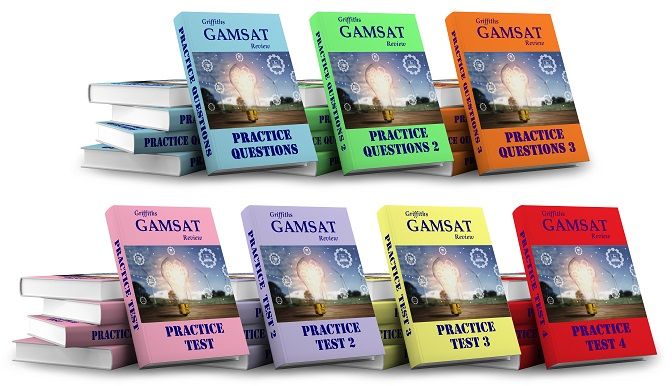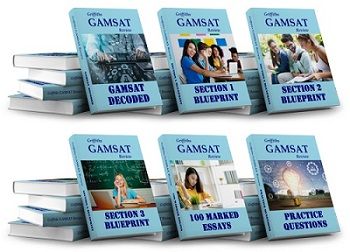GAMSAT Preparation Plan
A Gamsat preparation plan to help you prepare for the test. The plan you adopt to prepare for the GAMSAT (Graduate Australian Medical School Admissions Test) will determine the degree of success that you achieve.
Materials To Prepare For Gamsat
Overall Synopsis of the GAMSAT
Setting Up A Gamsat Study Plan
Detailed Strategies For The Individual Sections
How Much Time Do I Need To Prepare For Gamsat?
How Difficult is Gamsat?
What Happens If I Have To Retake GAMSAT?
Work/Life Balance While Studying For GAMSAT
Gamsat Preparation Tips From Real Students
A Personal Perspective
Compensating For A Lower Gamsat Score
Conclusion
The test has been carefully designed to assess potential candidates ability to undertake rigorous high level studies for entry to medicine, dentistry and other demanding health related fields.
Unlike most tests the GAMSAT is not testing your factual recall of data, facts etc. Rather it is testing a candidates ability to think, reason, make judgments' and solve problems. So while a prior knowledge of science for example in section 3 is useful (and in fact recommended by ACER) many questions can be answered with no prior knowledge.
For this reason a very different strategy to your test preparation for the GAMSAT will be required and this may not be what you are used to.

My strategy to prepare for the test can be defined as follows -
1. Know the test - careful analysis of the structure of the test and the skills required for all three sections is fundamental before you even begin to do anything. This knowledge will guide everything you do in the later stages of your study.
2. Scrutiny of the types of questions asked in each section.Having this knowledge will start to allow you to quickly recognize the pattern of questions and have pre-developed techniques ready to answer them.
3. Based on the knowledge gained in the above two steps we can begin to decide what needs to be studied and what skills need to be developed.
4. From there we establish a plan of attack and decide what materials we need to develop those skills and study the factual knowledge to the extent it is required.
5. Once the above process has started we put into practice the skills developed and the knowledge acquired through constant practice and testing. In the beginning we will use easier questions and tests to firmly drill in the basics as quickly as possible. Later we move on to actual GAMSAT level difficulty questions, using official materials from ACER as much as possible.
6. Review - in this step we review our performance from our practice questions and use this information to identify further areas of study, weak areas, etc.
Materials To Prepare For Gamsat
Now let's move on to some of the basic materials you'll need to purchase at the outset as an essential part of your Gamsat preparation. Unfortunately as you'll quickly discover sitting GAMSAT is not cheap, and I'm not just talking about money here but also your time investment which will be considerable.
Apart from the fee to sit the test (which is not small) you will also need to invest in practice papers, textbooks and probably also specialist GAMSAT books or courses. I'll set out here a bare minimum list to start with.
Later on I'll give more resources for each individual section of the test. But for the moment we'll keep it simple so can go through the process step by step and not become overwhelmed before you even start.
1. Let's go back to my list above about how to approach preparing for the test, step one was
"know the test"
So the first material to obtain is the GAMSAT Information Booklet which you can download for free from the ACER website in PDF format. Get this and read it cover to cover.
2. Once you've done this obtain the official ACER practice materials from the same website. Unfortunately these are not free.
Many people ask me if they really need to buy ALL of the ACER materials and my answer is always yes as they are still the best and most realistic way to practice actual GAMSAT style questions.
3. Decide what extra materials you are willing to invest in.

Do I Really Need To Buy Gamsat Prep Materials?
In a word yes.
That is based on the results of many scientific studies which show that performance in practically every kind of test can be improved by practicing the types of questions in the test.
This applies to both knowledge based tests and tests which are supposed to test innate abilities such as IQ tests or psychometric tests which are supposed to be impossible to prepare for.
The Institute of Psychometric Coaching for instance says -
" Current literature in psychometrics points to the fact that effective preparation improves test results in tests such as IQ, innovation and psychometric tests."
https://www.psychometricinstitute.com.au/Practice_and_psychometric_tests.html
An article in the Harvard Business Review stated -
" A review of 50 scientific studies with more than 130,000 participants shows that practice boosts performance on pretty much any kind of test"
https://hbr.org/2015/07/ace-the-assessment
This mirrors research done by the US Federal Trade Commission published in 1979 into the SAT test. This is a numerical and verbal reasoning test (therefore similar to Gamsat) for adults who wish to enter college.
Their research found that proper preparation could increase scores in verbal and numerical reasoning by 20 to 35 points on average.
Other research has confirmed these findings for example a 2008 study by Susanne Jaeggi and Martin Buschkuehl found that appropriate training could even improve base IQ.
https://www.nytimes.com/2012/04/22/magazine/can-you-make-yourself-smarter.html
Of course the most important materials you should buy first are the official ACER practice materials. Currently available are some Practice Questions and Sample questions both of which are equivalent to about half a full test each. Then there are 3 full length Practice Tests.
These will provide you with some good question practice however they won't give you detailed strategies and techniques for answering the questions. Another disadvantage about them is that although they tell you the correct answer choice for the multiple choice questions there are no worked solutions so if you can't work out how the answer is arrived at they don't help.
If you want more practice questions with fully worked answers there are heaps and heaps included in Griffiths Gamsat Review available from www.gamsatreview.com

Overall Synopsis of the GAMSAT
OK so now we've got our overall strategy developed let's go on to look at preparation for each of the three individual sections of the test.

Section 1 - Reasoning in the Humanities & Social Science
In a nutshell this section consists of 75 multiple choice questions to be completed in 100 minutes. In addition candidates will receive an extra 10 minutes reading time. The questions are designed to test your ability to rapidly understand complex verbal and visual information and make deductions based on the material given. The materials are composed of fiction, non-fiction, poetry, cartoons, graphs and diagrams.
Section 2 - Written Communication
Two essays to be written within 60 minutes. You will also be given an additional 5 minutes reading time. The essays must be written in response to the prompts which take the form of 4 or 5 quotes based on a common theme.
Section 3 - Reasoning in Biological & Physical Sciences
In a nutshell 110 multiple choice science questions to be answered in 170 minutes (plus 10 minutes reading time). Questions will be set on biology, physics and chemistry in the following proportions:
Biology - 40%
Chemistry - 40%
Physics - 20%
What level do I need to study to?
The official ACER advice is to study biology and chemistry to first year degree level and physics to A level standard.
In practice this can be difficult if you are not already a science graduate, in practice we have found that a good A level standard is sufficient for all three subjects. Please refer to Griffiths Gamsat Review for more detailed information on this topic.
For a detailed subject syllabus you should study for the three subjects you can download one for free from here - Gamsat Syllabus
Finally it is worth pointing out that while many sources of information about GAMSAT claim that no factual recall of anything is necessary you'll find it hard to reach the desired level without memorising anything so that claim is a little disingenuous and should be taken with a pinch of salt.
You Might Also Like...
How Long To Prepare For Gamsat?
How To Organise Your Gamsat Preparation
Hopefully by now you've seen the value of adopting a step by step approach to your Gamsat preparation. Without taking this approach the task can seem overwhelming and it's easy to get lost in the huge amount of information available.
So let's move on to some practicalities.
Setting Up A Gamsat Study Plan
In simple terms this involves deciding what you need to study and splitting it up into regular and manageable quantities so that you cover all the material before the test. Sounds easy right? But what's the best way to achieve this? A widely used goal setting methodology is the SMART system. This is an acronym which stands for
Specific
Measurable
Attainable
Relevant
Timely
So let's see in detail how this applies to setting up a Gamsat study schedule
Specific - we know we have to study humanities, biology, chemistry and physics but what exactly do you need to study for each subject. Should you include knowledge of particle accelerators in your physics study? (the answer is no by the way).
Measurable - so once you know exactly what and what not you are going to study you must be able to measure it and know when the task is finished e.g completing a specific 10 chapters in a chemistry book.
Attainable - the goals you set must be realistic and possible to achieve in the time you have left before the test. This will be easier if you are a year away from the test. If you are only a month away it is unlikely you can study a whole A level science syllabus so you'll have to prioritize the subjects you study to those most likely to come up in the test.
Relevant - Is what I'm doing relevant to the Gamsat? If I practice a question is it developing a skill relevant to the test i.e. problem solving or is it testing pure factual recall which is not a Gamsat skill.
Timely - How will you decide the unit in which to measure your goals so they are completed by the necessary date, will they be weekly? monthly? etc. Just as important here, as not trying to do too much in too little time here is to not allow too much time for each goal. Such an approach leads to complacency and inefficient time management. Allow just enough time so each task can be accomplished in a timely manner.
From the above we can see that the ideal approach will be to get an "at a view" year calendar where all the months can be seen in one view. Now mark the date of the next GAMSAT test. from there go backwards to today's date to see how much time you have left until the test. If for example it is 10 months then it is a relatively straightforward task to slot in all your study for each week and month from now until the test.
Further tips on your Gamsat study calendar:
1. Don't forget to allow time for revision and reinforcement of what you have studied.
2. Don't forget to allow time for sufficient question practice. In GAMSAT study this will be a significant amount of time since a single GAMSAT practice test can take a whole day.
3. Allow time for setbacks, no matter how religiously you try to stick to a plan life can always get in the way. You can become sick etc.
4. Finally if you see the timetable is not working don't be afraid to scrap it and write a new one.
Individual Study Sessions - The Details
Once we've got the macro or big picture plan established to our satisfaction as outlined above we now need to follow the same approach to our micro plan or individual study sessions.
If we plan on studying for one hour we need to make sure that what we will study in that time meets the SMART criteria as explained above. In addition how will we split up our one hour study session? How much will we attempt to do in that session?
Contrary to popular belief the human mind cannot concentrate for long periods of time. In fact it may surprise you to learn that scientific studies have proven that the optimal learning time for the human brain is just 20 minutes. I therefore recommend that a one hour session be divided as follows -
First 20 minutes - studying a new concept from your text book.
5 minute break.
Next 20 minutes attempting questions on the topic studied.
5 minute break.
Final 10 minutes re-reviewing the material studied in the first 20 minutes using our performance in the questions to guide us to areas where more in depth study is required.
Before you begin you should decide exactly what you are going to cover in the first 20 minutes and also have the questions you will attempt in the second 20 minutes decided in advance.
Final tips are to try and study in a quiet pleasant environment and try and study at the same time every day. This will aid you in establishing a routine and put your study plan on auto-pilot. This becomes even more important as you get near to the test day since you will likely become increasingly stressed and having to work out small details will only increase stress levels exponentially . By having a standard plan and routine to fall back on you have one less thing to worry about.
Seeing how you are steadily ticking off your goals in your study calendar and knowing that you are on course to finish by the test is an enormous psychological boost.

Detailed Strategies For The Individual Sections
Now let's turn our attention to some more specific advice for each of the individual sections of the GAMSAT.
Again there is much more that can be said about this than it is possible to fit into one short article, so what is written here is a basic introduction. For more detailed advice about each section you can read more in my other articles:
Preparing For GAMSAT Section 1
Preparing For GAMSAT Section 2
Preparing For GAMSAT Section 3
So let's look first of all at Section 1
While there are questions based on cartoons, graphs etc. the majority of questions in this section are based on texts, which may be either fiction or non-fiction. Texts are often taken from novels or non-fiction books.
However I do not recommend that you begin by starting to read entire books.
There simply isn't enough time to do that and you are unlikely to develop the comprehension skills required by such an approach. Rather I recommend that you begin reading short articles of the length which are likely to be in a GAMSAT text and as you read you should be constantly asking yourself what is the argument that the author is trying to make.
The best way to do this is to start reading articles from a variety of sources such as quality newspapers, magazines etc. Paper is better as it is the test format and allows you to underline, take notes in the margin etc. If you are working from online articles try and print them out.
Also try and read articles you would not normally read
It is vital that you become accustomed to reading unfamiliar material without becoming overawed or dismayed at encountering unfamiliar vocabulary or jargon.
In a quality newspaper you should find articles on business, economy, science, the arts etc.
Here are some particular resources you may find useful:
A quality daily newspaper:
https://www.theguardian.com/international
Free short stories:
https://americanliterature.com/100-great-short-stories
Poems -
https://www.poetryfoundation.org/poems
Section 2
As you probably already know in this section we need to write 2 essays within 60 minutes. The essays will have to be written based on a set of quotes. You can choose to write the essay based on one quote in particular or on the general theme of all the quotes. Successful preparation for this section involves -
1. Having a good essay writing model
2. Sufficient practice at implementing your model
Now here we can see a problem, while there are many good essay writing models out there, not all of them are suited to the specific task of extracting a topic from one or a set of quotes and turning it into an essay which can be reasonably argued from both points of view in just 30 minutes. So when investigating and choosing your essay writing model make sure that it can meet this criteria.
Once you have selected an appropriate model you then need to get sufficient practice on GAMSAT style quotes so you can turn out two essays on autopilot within an hour.
Here is an online quote generator to get random quotes:
Section 3
This is the section which usually induces the most fear and anxiety in potential candidates. Let me try and put your mind at rest especially if you do not have a science background.

Here are some useful resources to get your science preparation off the ground
Free online science lessons:
Professor Dave Explains
A good series of fun Youtube science tutorials:
https://www.youtube.com/channel/UC0cd_-e49hZpWLH3UIwoWRA/featured
How Much Time Do I Need To Prepare For Gamsat?
One of the most frequent questions that candidates ask is how long they need to prepare for to get ready for the test. The answer can vary considerably according to the individual and depends on multiple factors but the main point to consider is how much time daily or weekly you can devote to the task.
Someone who can study full time will need less preparation time than someone who has a full time job and can only study at the weekends for example. Another important issue to consider is how much pre-existing science knowledge you have. Someone with an existing degree in chemistry would need less time than someone with a music degree.
However, having said the above I would recommend starting your preparation at least six months before the test. This should give you enough time to cover everything as long as you are already well prepared in terms of your study plan.
It's essential that you know what you need to study and have the materials ready to go before you begin. If you start 6 months before and then after two months you realize that you don't really know what topics you are supposed to be studying or you still don't have a reliable essay template then you are likely to be on to a losing strategy.
How Difficult is Gamsat?
There is no doubt that GAMSAT is a very tough test. There are three main factors involved in its level of difficulty:
1. The breadth of knowledge required. Because the test requires knowledge of both humanities and science the sheer quantity of knowledge required makes it difficult.
2. Time pressure. Students frequently report that one of the most difficult aspects of the test is the time pressure involved. Most candidates report having to guess large numbers of questions due to running out of time. If this happens to you try not to worry too much. The test is probably designed to be this way.
3. The mental ability tested. Because Gamsat is primarily testing thinking skills through the medium of problem solving, interpreting complex data sets and pattern recognition etc we can regard it as a type of IQ test measuring a person's innate ability and intelligence. In this regard it is very difficult to improve your fundamental level of intelligence. Although as we shall see later it is not impossible with the right tools.
Yes the test is very difficult but the real question is not how difficult the test is but how well prepared are the people taking it. There is no set pass or fail mark in Gamsat. It is a competitive exam meaning that your success or failure is determined by your ranking according to other candidates. Normally you need to be in around the top 20% to have a chance at being called for university interviews. So worry less about the test and more about being better prepared than your rivals. Even if the test is extremely difficult in one particular year and no-one can complete more than 50% of the questions (to put an extreme example) there will still be a ranking with a top 20% of successful candidates. Likewise even if everyone sitting the test has the IQ of Einstein, 80% will still fail due to the ranking.
Your real enemy is not the test, rather it is the other people sitting the test
What Happens If I Have To Retake GAMSAT?

When I sat the test I was lucky enough to pass the first time in the top 10% of everyone in my cohort. Well, some of it was due to luck yes, but more so to the intense preparation I put in and my in depth study of the test and the Gamsat specific test taking strategies I developed for it.
But what if you are not so lucky? What happens if you don't make the cut and end up in the situation of having to re-sit in 6 months time? The first thing is to not be too disheartened. You aren't the only one, many people have to re-take the test before finally becoming successful. In my cohort at medical school there were many people who had sat the GAMSAT two or even three times before finally passing and then gaining a place on their desired course. Of course if you've already sat the test and failed three times it may be time to re-evaluate if this is for you, or maybe investigate other routes into your chosen career which don't involve Gamsat.
Now let's look at the positives if you do find yourself in the unfortunate position of having to re-sit the test.
First of all you aren't starting from zero. You've already put in a lot of work (hopefully, if not then maybe that is why you failed!) and starting from a solid base is much better than starting from scratch. You will undoubtedly enter the test next time with more knowledge and better prepared, it would be hard not to.
You're probably already well aware of your weak areas and can immediately move to address them in your Gamsat preparation this time round.
Secondly you now have experience of the test. You've done the dress rehearsal, you know what to expect. One of the big problems that students have is the uncertainty and apprehension surrounding this high stakes test. That translates into nervousness and self doubt all of which can affect performance on test day.
But you've been through it already and so have a big advantage over many of your competitors for the next time.
Work/Life Balance While Studying For GAMSAT
Because your whole future depends on the outcome of this test and due to the large amount of preparation necessary it can be easy to let the test completely dominate your life to the exclusion of all else.
While this level of commitment is admirable it is unlikely to be sustainable and could ultimately be prejudicial to your goals as it leads to burnout.
Here are some tips to help you avoid this situation and maintain a healthy work life balance:
1. Planning is key, plan your study times and stick to them. Keep them short and manageable.
2. Include specific time for social engagements/fun activities
3. Don't forget to do some exercise. Not only a gym session or going for a run two or three times a week but also remember to get up, stretch and walk around frequently while studying. Don't remain immobile at a desk for hours on end.
4. Don't kid yourself about unavoidable commitments. Work out what yours are and don't begrudge doing them.
5. Concentrate on your weak areas
6. Plan in a variety of types of study activity so you don't get bored.
Gamsat Preparation Tips From Real Students

I improved by 10 points. Practice lots of questions, initially do some not timed and assess the questions you got wrong and right. Ask yourself why you got right or wrong and try and understand the reasoning behind answer. Then do some timed tests and evaluate again. I found Des o’neil great for this. Try and read long passages with understanding.
And in spare time use Read Theory too .
Also note words you don’t understand and look them up. Use Acer papers for timed practice and again analyse. This practice will over time improve your reading speed and as you improve in your answers, you will speed up more. Read novels when you can, and again try and understand what you are reading, note unknown words. - Fozia
A good way for me to get going when I first started was to read other people's essays and then try to do similar ones with my own research/evidence/quotes, like an open book essay with no time limit. I would never submit one as its based it off of someone else's ideas but it was a good way for me to start writing without having to decide how I felt about a topic since I didn't have nay knowledge/experience. Then I progressed to reading the stimulus and I often found I immediately had a certain opinion and I did research and wrote based on that. Eventually I was able to just start writing based on knowledge I'd gained doing research from the previous topics. - Karen
I think the most important thing is to go head straight into the questions. Not all questions are made the same, and if you come across a particularly difficult one -respect it and take your time to carefully dissect it. Because not every question is made the same, you shouldn't really be thinking in quotas and stuff. Gamsat is a skills test, and you basically just do what you are comfortable with to improve your skills. I've seen so many people who basically just grind the shit out of pastpapers-some even say, I ran out of Des O Neill, should i move on to Gold Standard etc. If you are doing that, you are rushing. And when you are rushing, you aren't taking your time to understand and break down the harder questions. You aren't questioning yourself why something is wrong, why something is right, what I don't understand, where can i find this information, what does this information link to etc. At the very least, every question you see are 4 questions: why is this right? and 3 why is this wrong. Last September, I had some family issues, and only studied a month but still got 82 in section 3-and I think this is not because I did every question I could find, but I dissected and took the time to do some pretty damn good questions from the acer booklet(I did nothing else but Acer booklets). It just comes to show, it is not a grind. How much you actually do is really dependent on how much you can absorb, how much you can dissect depending on the questions. It probably takes me 1hour to dissect a very difficult question if I had some preliminary knowledge and probably 2 if I had no knowledge at all, and i'm more than happy if I only do 2 difficult questions a day rather than grind out 10 simple questions to fulfill a quota. - Robert
For section 1. read poetry. there's always poetry there. they have poetry on topics like love, war, justice etc.
Get the ACER questions. best investment you could do.
Also when I first started I read advice that you should skim read or reaf questions first. I personally found neither worked for me. your mileage may vary. when I skimmed I missed details. when I read questions I went searching for specific answers and missed the general theme.
For section 2 . Ted talks . Yes ...but don't just listen to anything. start with social justice issues. what do i mean? for example is the prison system working? others are racisim, welfare etc.
Also look at different forms of government. e.g. communism vs capitalism. Or should we have mandatory voting etc. Is technology good or bad?
don't ignore topics like love, gender equality, war and justice. e.g. is war a good or bad thing?
you need to listen to both sides. there's typically no single answer. - Mehdi
If you’re from a non-science background like me, watching lectures and referring to relevant textbooks is kind of essential. When I sat gamsat the first time I did brilliantly in sections one and two (namely because I have a BA and majored in English literature), but I failed section 3 miserably. Why? Because when I was reading question 3 questions it may as well of been written in a language other than English, so I had no idea what they were asking from me. So I guess this time around I’m just learning the language of science and then it’s just going to be PRACTISE, PRACTISE, PRACTISE! I hope this helps - Iris
I have found listening to podcasts YouTube channels etc helpful in terms of getting different perspectives on global issues. I'm generally not a curious mind and don't find global issues very interesting so I found i lacked perspective and my scope was very limited when addressing section 2. Some people also recommend reading the opinion section of the guardian, courier mail and the economist. Due to time constraints I find it hard to do this religiously but it definitely is a useful tool as it helps with vocabulary, spelling and interesting language expression. - Primrose
A Personal Perspective
By Jonathan

Introduction
It was April, the rigor of university examinations was behind me and my GAMSAT preparation loomed, set to consume my attention for the next month. With a plethora of resources, conflicting anecdotal advice, GAMSAT preparation companies and a new GAMSAT delivery system – I was at odds of where to begin.
Preliminary Approaches to Gamsat Preparation
I began by starting at the source, overviewing all the relevant publications produced by the Australian Council for Educational Research (ACER) who proctor these examinations. This provided valuable insight as it indicated the stresses of the examination, the format of the examination and trivial information such as allowed materials and timing.
ACER also offers a suite of preparatory materials including Practice tests and Sample questions which are modelled after previous papers. Given ACER’s relevance in producing these papers, I used these resources as a baseline to gauge my current level of knowledge. Upon attempting these papers with no time constraints, I corrected it and sought additional resources where needed to justify certain answers. After completing this process, I developed a spreadsheet recording my progress in each of the three sections. In a second document, I recorded each of the specific topics or themes that I encountered in each of the sections – i.e. Political oppression excerpt in Section 1, Point of view piece on originality in Section 2 and Genetics in Section 3. Alongside these headings, I indicated my performance and the number of questions related to these topics answered. This document I developed then served as the basis for my approach as it allowed me to determine my current level and future focuses.
Section Strategies
As well as resources, ACER also produces information on preparatory strategy which discusses commonly used techniques by other candidates. I used this as an indicator of possible starting points that could lead my development in each of the three sections.
Section 1 involves analysing various humanities-based stimuli and responding to questions that test upon the concepts outlined. I found that the most effective technique, although elementary, was to read various sections of the newspaper. This provides a unique exposure to foreign and complex topics that are often humanities based and rooted in sophisticated jargon. Moreover, sharpening up on specific humanities areas through different media could also develop the skill of interpreting various perspectives and provide familiarity when overviewing the stem of questions.
Section 2 involves producing two written pieces under a strict time pressure. It is often considered that writing a large volume of pieces is correlated with success in this section. However, to hone this section, it is often better to understand the writing process and develop a range of pieces responding to complex, abstract stimuli.
The position of assessors should also be considered while penning many of these pieces. The assessors of Section 2 are often required to mark many essays in a short period of time. Given this, they usually scan through the piece or read major blocks such as the conclusion or single body paragraphs. Pieces should therefore take a unique perspective to distinguish itself amongst other, encapsulate the reader and be fluid in their structure.
Section 3calls upon Scientific knowledge and the application of this to a range of contexts. The requirements of Section 3 are often misconstrued. Given it is based on science concepts, many candidates often fall into the trap of gaining as much scientific knowledge as possible. This while positioning candidates to synthesis scientific information more readily and providing familiarity while reading questions, it is not the most sustainable approach.
ACER stipulates that these questions are not aimed at pre-existing knowledge but are testing on the ability to deconstruct questions and respond to them in a particular way. Having some scientific knowledge is still important, but external resources can better serve to provide exposure to various diagrams to practice interpretation and response.
Anecdotal information
GAMSAT success is not novel among medical school hopefuls nor is it an oddity to see candidates from a range of backgrounds perform well. Therefore, there is a wealth of historical information and personal experiences that can help mould GAMSAT preparation plans.
However, there are many caveats to consider when scouring through these accounts. Some of these personal recounts are solely given to sell tutoring services. Other experiences are exaggerated or are often misleading, both misdirecting and providing false hope to candidates.
Therefore, a certain tact needs to be maintained while reviewing these anecdotes and it should be considered that these are experiences of a single individual, not the majority. As such they should be taken with a grain of salt and used to glean insight but should not dictate your entire GAMSAT journey.
Mental considerations
Upon reflection, another consideration that is often overlooked but equally important is mental fatigue and acuity. Given the lengthy nature of a GAMSAT paper, it is easy to be fatigued such that it often derails set study schedules, hinders progress, and often interprets the learning process.
Therefore, the best way I combated this was to devise a schedule that included my hobbies and time away from GAMSAT study. This allowed me to take a breath, reflect upon my progress so far and allowed me to maintain other aspects of my life.
Actual day
The actual day of the GAMSAT is the most important milestone of your preparation schedule. This provides the stage to provide your perspective on various topics and put into practice the many skills refined.
Many factors such as seeing other candidates, overestimating the significance of the GAMSAT, or being stressed about time could conjure nerves. Although natural, this may detract from your performance, but having an effective, established strategy is important to offsetting this.
As well, many mantras that are associated to performance external to the GAMSAT such as being content with your performance or putting your best forward, although repetitive, hold merit in maintaining focused throughout the GAMSAT and should be highly considered.
Compensating For A Lower Gamsat Score
While your Gamsat score is a critical component of your medical school application it is important to remember that it is only one part and other factors such as GPA, portfolio and so on will be equally important. Indeed some of these other factors can to some extent compensate for a lower Gamsat score and improve your overall chances of being accepted to the university of your choice.
Let's take a look at the most important ones:
GPA
Almost everyone knows that outstanding academic performance is paramount in the makings of an excellent medical student. It is usually the first aspect of an individual’s application that will be considered when ranking against other applicants. So how can you stand out as a prospective medical student among the masses? Many students have their own ideas for academic performance maximisation, but it just simply is not a one size fits all case. Due to the many varied learning styles and different personal circumstances, it is important to account for these differences and to be patient if certain “proven” or sworn-by study methods do not work for you. It is also important to understand that your first year of study is weighted much less than later years, so use that as an opportunity to experiment with your studying and content learning strategies to find the best method that works for you.
Not only is it important to hone in on a personalised learning method, but it is also important to be organised and strategic when selecting and planning out your course. For some, summer and winter units that can be completed during a university holiday are a popular choice, as they allow you to underload in the following semester and focus on more challenging units that require meticulous attention. Though it is important to consider whether that holiday is truly expendable in your personal situation. If it is the case that you are overworking yourself, continuing to study hard during the university break may lead to increased stress and not having ample time to rest, potentially leading to decreased academic performance in the subsequent semester. Therefore, this is something to be taken into consideration.
Furthermore, an extremely effective way to organise what you will be studying to optimise results is to take subjects that genuinely interest you. When you have a profound interest in that area, studying will be less of a chore and more like fulfilling a curiosity. For many, such interesting subjects can be considered easy grade boosters. This is of course markedly different to taking a subject solely because it guarantees high marks. One needs to consider whether taking such subjects is worth it by evaluating the content of the unit and the skills that you would be taking away from it. Some are willing to study easy subjects even if they are useless, but others prefer to choose the units they are paying decent money to study much more meticulously. Whether you undertake such units is of course down to personal preference, but it is definitely something to take into consideration.
Another thing to consider is that diversifying your degree beyond your main area of study through your electives may not only provide an opportunity to further improve your grades but could potentially also provide you with new, valuable and diverse skills that perhaps you would not have otherwise gained from your degree. For example, undertaking arts units that heavily assess essay writing, can put you in a position to improve your written communication skills, or taking a theatre or stage performance unit could give you an opportunity to sharpen your presentation skills. After all, your undergraduate degree may be your only opportunity to experiment and explore different areas of study before undertaking more intensive postgraduate study, so you might as well make the most of it.
Another frequently overlooked fact is that consistent attendance is the key to improved grades. Many studies time and time again return the same results linking frequent attendance to high academic performance. In addition, sometimes tutors and lecturers give out valuable tips and information in class as rewards for attendance, so be sure not to miss out! That being said, the most effective way to maximise your academic performance is to ensure that you are taking care of yourself both physically and mentally. If you are physically unwell, do not be afraid to give yourself time to rest. Overworking yourself will only make things harder and there are support systems in place in any university for a reason. Make sure to use such support if you need it, and to prioritise your wellbeing before anything else.
In that same vein, it is also important to prioritise your mental health, by listening to your body’s needs and taking rests when you need them. In actual fact, one should embrace the mindset of ensuring the utmost standard of self-care, as it is a valuable life skill that will be an indispensable asset for combatting medical school in future. On top of that, these days medical schools look for candidates that know how to take care of themselves primarily, before anything else, as these are the kinds of individuals who will be able to survive medical school and have bright and successful careers in the medical industry with less likelihood of burnout. Therefore, by looking after yourself you can optimise academic performance, while also developing an invaluable skill for tackling medical school, and aligning yourself more with an ideal medical school candidate. You’re killing more than two birds with one stone, so why not do it, right?
Choice Of Institution
GAMSAT score has different importance for different universities, for example the University of Sydney’s MD primarily takes GAMSAT score into consideration when ranking applicants and will only then use GPA as a tiebreaker. As specific section preparation tips have already been provided, I will only touch on general tips for optimising GAMSAT scores overall.
Firstly, outside of active preparation for the various GAMSAT sections, it is also important to be doing passive preparation, which involves reading as often as is feasible. The purpose of doing this is not particularly what information you are consuming - you can be reading whatever you like - but how you are able to consume that information. As GAMSAT is a long and arduous test that requires a considerable amount of reading under timed conditions, by consistently reading in the months leading up to the GAMSAT you can train yourself to be more efficient at digesting information as well as to increase your reading speed. By undertaking this form of passive preparation, you can save yourself considerable amounts of time and labour trying to quickly digest information on the actual day of the GAMSAT.
While passive preparation is absolutely beneficial, active preparation should also be consistently completed. Preparation through completing timed mock GAMSATs using the ACER materials or any other materials available is an excellent way to prepare yourself for the big day. The more mock exams you can squeeze in before the day, the faster you will become at getting through questions and the less pressure you will feel on the actual day. This is because mock GAMSATs are designed to mimic the time conditions that you will be faced with on the day, therefore by practicing sittings in the same time conditions you are essentially alleviating the fear of the unknown, hence reducing some of the pressure and anxiety when it comes to sitting the real thing.
Another key factor in getting the most out of your performance on the day of the GAMSAT is to get plenty of rest the night before and eliminate stresses on the day. This means being organised, knowing your testing location and how you will be getting there, well before the day arrives. It also means ensuring you have your admission ticket printed and your valid form of identification ready well beforehand. In addition, ensure that you check that the expiry date on your form of identification will not expire before the day of the GAMSAT, otherwise it will not be valid and may not be accepted on the day. Also, be sure to prepare what you will be wearing at least the night before, and make sure that you dress as comfortably as you can. As ACER advises, it is ideal to wear layers as it is likely they will not adjust the temperature for your preference at the venue. Also, try to avoid clothes that make a lot of noise when you move around, as it can be distracting for both you and the people around you.
The other advisable tip for maximising your GAMSAT score is to give yourself as many chances as possible to achieve your highest score. This entails knowing how many sittings will be counted at the time of your application. This information, specific to your year of application to medical school, can be found on the ACER website but on the whole it is usually four sittings (September of first year of undergraduate degree, March of second year of undergraduate degree, September of second year of undergraduate degree and March of third year of undergraduate degree). By understanding how many sittings you can complete that are counted towards your medical school application you can give yourself more chances to improve than if you were to do the one March sitting on the year of medical school applications. This not only gives you more opportunities to improve, but also prepares you in the case that things go wrong such as not being able to complete a sitting due to an illness or accidentally missing the registration cutoff date. This is because oftentimes if you are unwell for a sitting they do not allow you to retake until the next sitting, and if you are only taking the March sitting on the year of medical school applications, you will therefore be rendered ineligible for that year’s intake. Therefore, this situation can be easily avoided by undertaking multiple sittings. Furthermore the more you take official GAMSAT sittings, the more prepared you are and practice you give yourself in order to hopefully improve in future sittings.
Another thing to keep in mind is that September sittings have a significantly lower number of candidates in comparison to the March sitting and as the GAMSAT results are fitted to a bell curve, generally more candidates sitting the test indicates that it is more difficult to score highly in that particular sitting. As a result, it is common for candidates to score much better in their September sitting than their March sitting, and while this is not always the case it is definitely something that should be taken into consideration if you have to choose between sittings.
Portfolio
Not all universities require a portfolio, the most well-known portfolio universities would be the University of Notre Dame and the University of Wollongong. However, taking the time to write one can be quite helpful to prepare you for interviews, even if you are not planning on applying to one of the universities that require a portfolio.
A few useful pointers for writing portfolios is to be candid and totally genuine, as this shines through emotionless, inauthentic or specially curated responses that are meant to mirror what they think the medical acceptance team would envision as an ideal candidate. The best way to write a successful portfolio is to be honest, to be you, and to show how your own personal experiences have provided you with opportunities to learn and grow as an individual.
Also do not be afraid to seek help or feedback when writing your portfolio, even if you are confident with your written communication skills. It always helps to ease concerns if you have your portfolio read by professionals who know what to look for and can provide helpful and constructive advice.
Honours Year
An Honours Year is a year-long program that can be undertaken upon completing a relevant undergraduate degree. For most medical school candidates, with a science-based background, an honours program involves being engaged in research into a particular area of study under the purview of a supervisor.
This program provides a breather from traditional coursework and allows for practical skills learnt to be put into useful practice. Additionally, some of the research conducted can have a clinical component, providing exposure to patients and hospital settings - giving students a taste of their future career.
Students also have the choice in deciding which research question and area of study they’d like to explore. This serves to identify an area of interest that can later be explored during medicine or be focused on in future specialties or practice. As well, given the practical exposure given, it may also provide the opportunity to reflect and to discover if the marathon of becoming a doctor suit you.
The most important detail, that applies to most universities, is that an Honours Year provides an opportunity to salvage your GPA. It does so by shifting the GPA calculation to include the Honours Year, 3rd Year and 2nd Year, excluding first year performance from the entire calculation. Additionally, if you opt to undertake an Honours Year at a particular university with a budding medical school, you may be eligible for entry bonuses that are set aside for alumni. Finally, an Honours Year can be the basis for talking points during medical school interviews that can speak to candidate motivation and to uniquely separate yourself from other applicants.
Further studies
Further studies can include undertaking an Honours Year as mentioned, but can also include undertaking PhD or Masters programs.
These programs function in a similar way to an honours year, allowing for particular areas of studies to be honed in on but often run for longer periods of time. Many students equate undertaking these further postgraduate studies as ‘failing to get into medicine’. In actuality, these programs provide the same inroad into Medicine as undergraduate studies, with a few more years of experience and more esteemed qualifications. As well, many leading doctors have also undertaken further studies in fields of interest through a PhD or Masters and so these studies are not just throwaways for the pursuit of Medicine but can be recognised later. Similar to Honours Programs, these studies can be clinical-based and provide that way to gauge if a Medical career is right. If not, these programs are still useful in pursuing other career opportunities that may interest candidates to pursue.
In terms of Medical school entry, the strongest selling point of further studies is that depending on the university, they may award applicants a perfect GPA of 7. This will ease the burden of a large criteria of getting into medicine and will get you closer to securing a place.
Apply Interstate / Abroad
The medical school landscape in Australia is very limited with only a few universities offering medical school programs.
This differs with international counterparts like the United States which have a more established medical school network. Although the academic track to becoming a doctor in the U.S. mirrors that of Australia, the large variety of medical schools sees a more diverse range of criteria that can better provide opportunity to underperforming candidates. More funding and the establishment of new medical schools is also commonplace internationally and therefore should be closely considered!
But not to dismiss the programs within Australia, as well applying interstate to other universities is another key consideration when thinking about Medical school applications. Some universities within Australia often do not consider GAMSAT as their primary criteria for selection or have different requirements that can cater to student profiles.
Undergraduate Courses
Often overlooked because of the additional length of study, many universities have a small intake into their undergraduate medical programs set aside for students who have an undergraduate degree.
These spots often require other forms of psychometric testing similar to the GAMSAT and continued academic achievement throughout undergraduate studies. Given many students are set on postgraduate studies, these spots are often overlooked and can be an additional avenue into pursuing medicine – so worth some research into!
Equity Schemes
Many schemes exist in order to make medical school entry as equitable as possible and to ensure the disadvantages faced by candidates during their studies are considered.
Many Universities have these Special consideration frameworks that can be accessed by completing an application, providing an explanation of the circumstances and the relevant supporting evidence. Eligibility is based on a range of criteria based on a Candidates profile: if they are rural, are from an isolated area or identify as Indigenous Australian. These special consideration applications also account for more specific disadvantages such as: Socio-economic status, Personal difficulties, Disability or Medical conditions. These schemes primarily function by increasing the cumulative GPA and GAMSAT score by a percentage point or providing candidates greater access to receiving a coveted Commonwealth Supported Program (CSP).
Some Universities as well only admit or award bonuses to candidates who have studied at their institutions. These schemes should often be considered at the start of undergraduate studies or can be accessed by completing short courses. So many considerations to be made!
Conclusion
Entry into Medicine is extremely challenging, calling upon the brightest of candidates with outstanding academic records, demonstrated motivations for wanting to pursue Medicine and a genuine concern for the needs of others. Candidate profiles should also stress professional acumen and skills aside from academic excellence that will facilitate to the responsibilities of a Doctor.
Although the Medical school selection process is often criticised for being ostensibly unfair and elusive, such a process lends itself to ensuring a certain calibre of candidate is maintained. Therefore, the need for these checkpoints to filter out certain candidates is justified in order to ensure the integrity of medicine is upheld and that the candidates can meet the exceedingly high standards to survive and flourish in this ambitious and taxing journey of a doctor.
Getting into Medicine is a difficult endeavour even for the brightest of candidates as many considerations are made before offers are sent out. Hopefully, these tips will bring you closer to entering your target university and fulfilling your dreams of pursuing medicine.

Further Resources
For more help with GAMSAT please check out Griffiths GAMSAT Review Home Study System which takes you step by step through all 3 sections and gives you advanced strategies for each.

